
Wine Culture and Information since 2002 - Volume 22
 Wine Culture and Information since 2002 - Volume 22 |
|
Contrasts of Alto Adige Lagrein Kretzer and Salento RosatoRosé wines are a great heritage of enology, not only of the Italian one. Capable of surprising with their aromas and crispness, they represent a sensorial world on their own |
|
Rosé wines have always been considered in a very particular wine category. It must be said that, in recent years, the reputation and interest in rosé wines has finally changed, gradually gaining greater market and consumption consensus. Perhaps due to the fact they are – so to speak – halfway between whites and reds, rosé wines have always been considered lesser children of Bacchus. The reasons which led to this lack of consideration are many, two in particular. In past times, producers, with very few exceptions, destined for this type of wine both grapes of lesser value and the use, from a qualitative point of view, of non always impeccable wine making techniques. Secondly, and this evidently applies to every wine – no type or style excluded – but in particular for these wines: making a high quality rosé wine is decidedly difficult. Much more than a white, even more than a red wine. Fortunately, in recent decades things have changed – quite a lot – and, finally, producers are dedicating the same efforts and commitment they usually reserve to whites and reds. Rosé wines have grown in terms of quality and that group of very few exceptions of the past has been joined today by many other wines of high enological value. This is an enormous advantage of which the wine world should benefit from, as there are many Italian production disciplinary – from north to south, crossing the whole country – which provide for rosé wines. The wines we will examine in the tasting by contrast of this month belong to two areas having a long tradition in the production of this style of wine. Alto Adige Lagrein Kretzer and Salento Rosato are two extraordinary representatives of this category of wines, certainly among the most famous examples in Italy, although not the only ones. Different characters and grapes leading to the creation of two wines that, in common, have the pink color only.
|
|
Lagrein is the most famous and significant autochthonous red berried variety of South Tyrol. Capable of producing wines of extraordinary character, it is traditionally vinified in the styles dunkel – that is, “dark” by using the typical red wine making technique – and kretzer, vinified in “rosé”. Lagrein is inextricably linked to Gries – one of the five districts of Bozen – and, in particular, to the Benedictine abbey of Muri-Gries, for centuries involved to the production of wine with this grape. The origin of Lagrein is not entirely clear and in the past it was assumed – due to the assonance of its name – it is variety from Vallagarina, in Trentino. Another recurring hypothesis supports the origin of Lagrein from the ancient city of Lagaria of Magna Grecia, in Lucania, today's Basilicata, and its famous wine Lagaritanos. In both cases, the assumptions are mainly based on the assonance of the name rather than on reliable evidence. Genetic research conducted on Lagrein however deny the Lucanian origin of this grape. According to DNA analysis, it was discovered this grape is actually a spontaneous cross between Teroldego and an unidentified grape variety, however with characteristics similar to Schiava Gentile. In both cases, they are varieties of these territories, therefore confirming the indigenous origin of Lagerin and, furthermore, confirms the hypothesis that the name derives from the Germanization of Lagarina, therefore the homonymous valley. Lagrein Kretzer – that is the rosé style – takes its name from the kroizere, the traditional wicker trellis used to separate the skins from the must during fermentation. This operation therefore allows to obtain a wine with a rosé color, light and crisp, quite different, and not only for the dark and intense color, from the dunkel style and with a remarkable structure. With the aim of enhancing and preserving the crisp and light character, in addition to the pleasant expression of red fruits, Lagrein Kretzer is generally vinified in inert containers, such as steel tanks.
|
||||
|
Salento, an enchanting territory in the most extreme part of Apulia, is identified – more than any other part of Italy – with the production of rosé wines. Here, of course, are also produced white and red wines, however the link between Salento and rosé wines is indissoluble and very strong. This large territory of Apulia is classified by the Italian quality system as Indicazione Geografica Tipica (Typical Geographical Indication, IGT) and inside are also found many Denominazione d'Origine Controllata areas (Denomination of Controlled Origin, DOC). Salento is also home to one of the most interesting red berried varieties of Apulia and, not least, of Italy: Negroamaro. This interesting red grape, in addition to be widely used in many red wines from Apulia, is the dominant and main variety of Salento rosé wines, often used alone, not least, blended to other varieties, including the so-called international grapes, such as Cabernet Sauvignon. The most frequent companion of Negroamaro is undeniably Malvasia Nera, a blend we find in both red and rosé wines of Salento. Negroamaro, capable of producing robust and structured wines, with perceptible astringency conferred by tannins, in fact benefits from the elegant qualities of Malvasia Nera which is capable of mitigating its roughness and, at the same time, making the olfactory profile more elegant. The finesse of Malvasia Nera is more appreciable in rosé wines, accentuating both the crispness and the aromatic exuberance of flowers and red-fleshed fruits. However, the character of Negroamaro remains evident, giving a well-perceptible structure which, together with the alcohol content given by the richness of grape sugars, make Salento rosé wines among the most robust ones of the Italian wine scene. Vinification is in most cases carried out in inert containers – steel and cement tanks – and the use of the cask is rarely used, a practice giving a more accentuated roundness and structure.
|
We are now going to choose the two bottles that we will examine in the tasting by contrast of this month. We will pay attention to the composition of the wines, as – in both cases – the respective production disciplinary allow the use of more than one grape. This characteristic is common to almost all the Italian production disciplinary, even those having in the label a single name of variety, which must be present for a minimum of 85%. This consideration is particularly important for the choice of Alto Adige Lagrein Kretzer: we will therefore make sure the wine is produced exclusively with this variety. As for the choice of Salento Rosato, we will make sure it is mainly made up of Negroamaro and the remaining part of Malvasia Nera. In both cases, the vinification is carried out in inert containers – preferably in steel tanks – and belonging to the most recent vintage. The wines are served at a temperature of 12 °C (54 °F) and poured in tasting glasses. Let's pour the two wines into their respective glasses and start our tasting by contrast. The first wine we examine is Alto Adige Lagrein Kretzer. Tilt the glass over a white surface – a napkin or a sheet of paper is enough – and look at the base of the wine. We can see a light cherry pink color and a high transparency: the object placed in contrast between the glass and the white surface is clearly visible. The nuance of the wine – observed at the edge, towards the opening of the glass – confirms the basic color, that is cherry pink. Let's move on to the observation of the color and transparency of Salento Rosato, taking into consideration the appearance of the wine at the base of the glass. The color of the Apulian wine is more intense than the South Tyrolean wine: we notice in fact an intense and brilliant hue of deep cherry pink, with evident hints of ruby red. The transparency is high however lower than that of Alto Adige Lagrein Kretzer. The nuance of Salento Rosato – observed at the edge of the glass – shows a bright cherry pink hue tending to salmon pink. The olfactory profiles of rosé wines, also because of the wine making techniques generally used for their production and which prefer the use of inert containers, are characterized by the fresh aromas of red pulp fruits and flowers. This characteristic is clearly perceptible both in Alto Adige Lagrein Kretzer and in Salento Rosato. The sensations recalling fruit are usually reminiscent of those having a red pulp, however, in many cases, it is possible to perceive aromas of apple and peach as well as certain types of tropical fruits. Among the sensations reminiscent of flowers, the most frequent ones are rose and cyclamen, in many cases, moreover, the pleasant aroma of violet is also perceived. The olfactory sensations reminiscent of dark pulp fruits – such as black cherry, blackberry, blueberry and plum – are less frequent but not entirely unrelated to this type of wine. Furthermore, in rosé wines, depending on the grapes and the territory of origin, it is possible to perceive aromas reminiscent of aromatic herbs as well. Let's resume the tasting by contrast of this month by proceeding with the evaluation of the olfactory profiles of Alto Adige Lagrein Kretzer and Salento Rosato. The first wine we are going to evaluate, just like in the previous phase, is Alto Adige Lagrein Kretzer. By keeping the glass in vertical position and, without swirling, we do the first smell in order to evaluate the opening of the wine, that is the first identifying aromas, often defined as primary nose. The South Tyrolean wine is characterized by intense and pleasing aromas of cherry, raspberry and strawberry, followed by the pleasing aroma of cyclamen. Let's proceed with the swirling of the glass – operation which favors the development of the remaining aromas – and do the second smell. The olfactory profile of Alto Adige Lagrein Kretzer is completed with plum, blueberry, blackberry and hints of peach. Let's now pass to the evaluation of Salento Rosato, starting from the analysis of the opening of the wine. From the glass we perceive intense and clean aromas of black cherry, raspberry and plum, to which follow a pleasing aroma of rose. After having swirled the glass, the profile of the wine is completed with peach, blueberry, cyclamen, blackberry and strawberry. Let's move on to the gustatory evaluation of the two wines. The first wine we evaluate, just like in the previous phases, is Alto Adige Lagrein Kretzer. We take a sip of the South Tyrolean wine and evaluate the attack, that is, the initial gustatory sensations that are perceived in the mouth. Lagrein Kretzer is characterized by a crisp attack and good acidity, a moderate body – definitely distant from the dunkel style – as well as a hint of astringency, however pleasing. The balance is obtained by the effect of alcohol, generally of moderate volume, and the flavors of cherry, raspberry and strawberry are perceived in the mouth. Let's now take a sip of Salento Rosato and evaluate its attack. Also in this case it is perceived the pleasing crispness given by acidity and, compared to Lagrein Kretzer, the wine has a decidedly rounder character and the effect of alcohol is more intense, enough to give a proper balance. In the mouth we also perceive the flavors of black cherry, raspberry, plum and strawberry. The last phase of the tasting is about the evaluation of the final sensations the wines leave in the mouth, paying attention – in particular – to the taste-olfactory persistence. The finish of Alto Adige Lagrein Kretzer is persistent in which we can continue to perceive, intense and clean, the flavors of cherry, raspberry and strawberry, as well as the pleasing crispness which characterizes this wine. The finish of Salento Rosato is equally persistent and in the mouth, compared to Lagrein Kretzer, we can perceive the more intense sensation of roundness and of alcohol. Also in this wine we can perceive the pleasing sensation of acidity in addition to the flavors of black cherry, raspberry, plum and strawberry. Let's now do a final evaluation of the wines by placing the two glasses side by side. The difference in color is evident and, not least, in the aromas. Furthermore, the differences in structure, acidity and softness are easily identifiable.
|
||||||||
Wines of the Month |
|
|
|
Score legend Prices are to be considered as indicative. Prices may vary according to the country or the shop where wines are bought |

|
|
Campi Flegrei Falanghina Vigna del Pino 2017 |
|
| Agnanum (Campania, Italy) | |
 Falanghina Falanghina | |
| Price: € 30.50 | Score: |
 Brilliant golden yellow and nuances of golden yellow, very transparent. Brilliant golden yellow and nuances of golden yellow, very transparent. Intense, clean, pleasing and refined, starts with hints of plum, apple
and citrus fruits followed by aromas of pear, medlar, hawthorn, broom,
chamomile, acacia honey and mineral. Intense, clean, pleasing and refined, starts with hints of plum, apple
and citrus fruits followed by aromas of pear, medlar, hawthorn, broom,
chamomile, acacia honey and mineral.
 Crisp attack and however balanced by alcohol, good body, intense
flavors, agreeable. Crisp attack and however balanced by alcohol, good body, intense
flavors, agreeable.
 Persistent finish with flavors of apple, plum and medlar. Persistent finish with flavors of apple, plum and medlar. 6 months in steel tanks, 10 months in cask. 6 months in steel tanks, 10 months in cask. |
|
 Pasta with fish, Sauteed white meat, Broiled crustaceans, Mushroom soups Pasta with fish, Sauteed white meat, Broiled crustaceans, Mushroom soups |
|

|
|
Campi Flegrei Piedirosso Vigna delle Volpi 2016 |
|
| Agnanum (Campania, Italy) | |
 Piedirosso Piedirosso | |
| Price: € 30.50 | Score: |
 Intense ruby red and nuances of garnet red, little transparency. Intense ruby red and nuances of garnet red, little transparency. Intense, clean, pleasing, refined and elegant, starts with hints of
black cherry, plum and raspberry followed by aromas of blueberry,
strawberry, cyclamen, dried violet, chocolate, tobacco, black pepper,
walnut, thyme, vanilla and menthol. Intense, clean, pleasing, refined and elegant, starts with hints of
black cherry, plum and raspberry followed by aromas of blueberry,
strawberry, cyclamen, dried violet, chocolate, tobacco, black pepper,
walnut, thyme, vanilla and menthol.
 Properly tannic attack and however balanced by alcohol, good body,
intense flavors, pleasing crispness. Properly tannic attack and however balanced by alcohol, good body,
intense flavors, pleasing crispness.
 Persistent finish with flavors of black cherry, plum and raspberry. Persistent finish with flavors of black cherry, plum and raspberry. 12 months in cask. 12 months in cask. |
|
 Stuffed pasta with mushrooms, Roasted meat, Stewed meat with mushrooms Stuffed pasta with mushrooms, Roasted meat, Stewed meat with mushrooms |
|
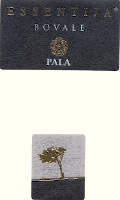
|
|
Essentija 2015 |
|
| Pala (Sardinia, Italy) | |
 Bovale Bovale | |
| Price: € 20.00 | Score: |
 Intense ruby red and nuances of garnet red, little transparency. Intense ruby red and nuances of garnet red, little transparency. Intense, clean, pleasing, refined and elegant, starts with hints of
plum, black cherry and blackberry followed by aromas of dried violet,
blueberry, raspberry, tobacco, cocoa, leather, licorice, vanilla and
menthol. Intense, clean, pleasing, refined and elegant, starts with hints of
plum, black cherry and blackberry followed by aromas of dried violet,
blueberry, raspberry, tobacco, cocoa, leather, licorice, vanilla and
menthol.
 Properly tannic attack and however balanced by alcohol, good body,
intense flavors, pleasing roundness. Properly tannic attack and however balanced by alcohol, good body,
intense flavors, pleasing roundness.
 Persistent finish with flavors of plum, black cherry and blackberry. Persistent finish with flavors of plum, black cherry and blackberry. 4 months in cement tanks, 3 months in barrique, 2 months in steel
tanks. 4 months in cement tanks, 3 months in barrique, 2 months in steel
tanks.
|
|
 Broiled meat and barbecue, Roasted meat, Stewed meat, Hard cheese Broiled meat and barbecue, Roasted meat, Stewed meat, Hard cheese |
|
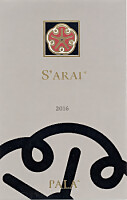
|
|
S'Arai 2016 |
|
| Pala (Sardinia, Italy) | |
 Cannonau (40%), Carignano (30%), Bovale (30%) Cannonau (40%), Carignano (30%), Bovale (30%) | |
| Price: € 40.00 | Score: |
 Deep ruby red and nuances of garnet red, little transparency. Deep ruby red and nuances of garnet red, little transparency. Intense, clean, pleasing, refined and elegant, starts with hints of
plum, blackberry and black cherry followed by aromas of dried violet,
blueberry, tobacco, cocoa, leather, mace, licorice, vanilla and eucalyptus. Intense, clean, pleasing, refined and elegant, starts with hints of
plum, blackberry and black cherry followed by aromas of dried violet,
blueberry, tobacco, cocoa, leather, mace, licorice, vanilla and eucalyptus.
 Properly tannic attack and however balanced by alcohol, full body,
intense flavors, pleasing roundness. Properly tannic attack and however balanced by alcohol, full body,
intense flavors, pleasing roundness.
 Persistent finish with flavors of plum, black cherry and blackberry. Persistent finish with flavors of plum, black cherry and blackberry. 10 months in barrique, 4 months in bottle. 10 months in barrique, 4 months in bottle. |
|
 Game, Roasted meat, Stewed and braised meat, Hard cheese Game, Roasted meat, Stewed and braised meat, Hard cheese |
|
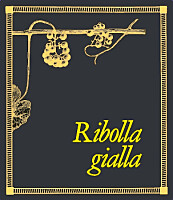
|
|
Ribolla Gialla Brut Millesimato 2015 |
|
| Collavini (Friuli-Venezia Giulia, Italy) | |
 Ribolla Gialla Ribolla Gialla | |
| Price: € 36.00 | Score: |
 Intense straw yellow and nuances of golden yellow, very transparent,
fine and persistent perlage. Intense straw yellow and nuances of golden yellow, very transparent,
fine and persistent perlage.
 Intense, clean, pleasing and refined, starts with hints of green apple,
hawthorn and bread crust followed by aromas of pear, citrus fruits, peach,
kiwi, plum, broom and mineral. Intense, clean, pleasing and refined, starts with hints of green apple,
hawthorn and bread crust followed by aromas of pear, citrus fruits, peach,
kiwi, plum, broom and mineral.
 Crisp and effervescent attack, however balanced by alcohol, good body,
intense flavors, agreeable. Crisp and effervescent attack, however balanced by alcohol, good body,
intense flavors, agreeable.
 Persistent finish with flavors of green apple, pear and peach. Persistent finish with flavors of green apple, pear and peach. Part of the base wine is fermented in steel tanks and part in barrique.
Refermented in closed tank on its lees for at least 30 months. 12 months in
bottle. Part of the base wine is fermented in steel tanks and part in barrique.
Refermented in closed tank on its lees for at least 30 months. 12 months in
bottle.
|
|
 Fish appetizers, Pasta with fish and crustaceans, Stewed fish, Broiled crustaceans Fish appetizers, Pasta with fish and crustaceans, Stewed fish, Broiled crustaceans |
|
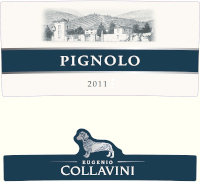
|
|
Colli Orientali del Friuli Pignolo 2011 |
|
| Collavini (Friuli-Venezia Giulia, Italy) | |
 Pignolo Pignolo | |
| Price: € 55.00 | Score: |
 Intense ruby red and nuances of garnet red, little transparency. Intense ruby red and nuances of garnet red, little transparency. Intense, clean, pleasing, refined and elegant, starts with hints of
plum, blackberry and black cherry followed by aromas of dried violet,
blueberry, black currant, tobacco, leather, cocoa, mace, licorice, vanilla
and eucalyptus. Intense, clean, pleasing, refined and elegant, starts with hints of
plum, blackberry and black cherry followed by aromas of dried violet,
blueberry, black currant, tobacco, leather, cocoa, mace, licorice, vanilla
and eucalyptus.
 Properly tannic attack and however balanced by alcohol, full body,
intense flavors, agreeable. Properly tannic attack and however balanced by alcohol, full body,
intense flavors, agreeable.
 Persistent finish with flavors of plum, blackberry and black cherry. Persistent finish with flavors of plum, blackberry and black cherry. At least 5 years in barrique, at least 2 years in bottle. At least 5 years in barrique, at least 2 years in bottle. |
|
 Game, Roasted meat, Stewed and braised meat, Hard cheese Game, Roasted meat, Stewed and braised meat, Hard cheese |
|
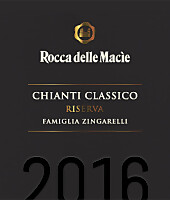
|
|
Chianti Classico Riserva Famiglia Zingarelli 2016 |
|
| Rocca delle Macie (Tuscany, Italy) | |
 Sangiovese (90%), Cabernet Sauvignon (5%), Merlot (5%) Sangiovese (90%), Cabernet Sauvignon (5%), Merlot (5%) | |
| Price: € 22.00 | Score: |
 Intense ruby red and nuances of garnet red, moderate transparency. Intense ruby red and nuances of garnet red, moderate transparency. Intense, clean, pleasing, refined and elegant, starts with hints of
plum, black cherry and violet followed by aromas of blueberry, black
currant, blackberry, raspberry, chocolate, tobacco, cinnamon, vanilla and
menthol. Intense, clean, pleasing, refined and elegant, starts with hints of
plum, black cherry and violet followed by aromas of blueberry, black
currant, blackberry, raspberry, chocolate, tobacco, cinnamon, vanilla and
menthol.
 Properly tannic attack and however balanced by alcohol, good body,
intense flavors, agreeable. Properly tannic attack and however balanced by alcohol, good body,
intense flavors, agreeable.
 Persistent finish with flavors of plum, black cherry and black currant. Persistent finish with flavors of plum, black cherry and black currant. 2 years in cask, at least 3 months in bottle. 2 years in cask, at least 3 months in bottle. |
|
 Broiled meat and barbecue, Roasted meat, Stewed and braised meat with mushrooms Broiled meat and barbecue, Roasted meat, Stewed and braised meat with mushrooms |
|
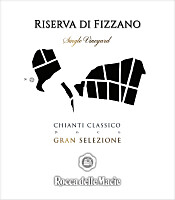
|
|
Chianti Classico Gran Selezione Riserva di Fizzano 2015 |
|
| Rocca delle Macie (Tuscany, Italy) | |
 Sangiovese (93%), Colorino (7%) Sangiovese (93%), Colorino (7%) | |
| Price: € 35.00 | Score: |
 Intense ruby red and nuances of garnet red, little transparency. Intense ruby red and nuances of garnet red, little transparency. Intense, clean, pleasing, refined and elegant, starts with hints of
black cherry, plum and violet followed by aromas of blueberry, raspberry,
rose, tobacco, chocolate, leather, mace, vanilla and menthol. Intense, clean, pleasing, refined and elegant, starts with hints of
black cherry, plum and violet followed by aromas of blueberry, raspberry,
rose, tobacco, chocolate, leather, mace, vanilla and menthol.
 Properly tannic attack and however balanced by alcohol, good body,
intense flavors, agreeable. Properly tannic attack and however balanced by alcohol, good body,
intense flavors, agreeable.
 Persistent finish with flavors of black cherry, plum and blueberry. Persistent finish with flavors of black cherry, plum and blueberry. 24 months in cask and barrique, 12 months in bottle. 24 months in cask and barrique, 12 months in bottle. |
|
 Broiled meat and barbecue, Roasted meat, Stewed meat with mushrooms, Hard cheese Broiled meat and barbecue, Roasted meat, Stewed meat with mushrooms, Hard cheese |
|
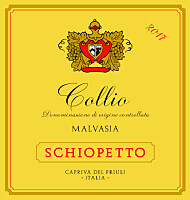
|
|
Collio Malvasia 2017 |
|
| Schiopetto (Friuli-Venezia Giulia, Italy) | |
 Malvasia Istriana Malvasia Istriana | |
| Price: € 19.50 | Score: |
 Pale straw yellow and nuances of greenish yellow, very transparent. Pale straw yellow and nuances of greenish yellow, very transparent. Intense, clean, pleasing and refined, starts with hints of apple, peach
and pear followed by aromas of citrus fruits, hawthorn, pineapple, jasmine,
plum, broom and almond. Intense, clean, pleasing and refined, starts with hints of apple, peach
and pear followed by aromas of citrus fruits, hawthorn, pineapple, jasmine,
plum, broom and almond.
 Crisp attack and however balanced by alcohol, good body, intense
flavors, agreeable. Crisp attack and however balanced by alcohol, good body, intense
flavors, agreeable.
 Persistent finish with flavors of apple, peach and pineapple. Persistent finish with flavors of apple, peach and pineapple. 8 months in steel tanks, at least 5 months in bottle. 8 months in steel tanks, at least 5 months in bottle. |
|
 Fish appetizers, Pasta with fish and crustaceans, Sauteed fish Fish appetizers, Pasta with fish and crustaceans, Sauteed fish |
|
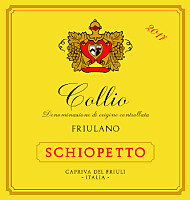
|
|
Collio Friulano 2017 |
|
| Schiopetto (Friuli-Venezia Giulia, Italy) | |
 Friulano Friulano | |
| Price: € 19.50 | Score: |
 Brilliant straw yellow and nuances of straw yellow, very transparent. Brilliant straw yellow and nuances of straw yellow, very transparent. Intense, clean, pleasing and refined, starts with hints of apple, plum
and citrus fruits followed by aromas of pear, hawthorn, elder flower,
pineapple, broom, peach and almond. Intense, clean, pleasing and refined, starts with hints of apple, plum
and citrus fruits followed by aromas of pear, hawthorn, elder flower,
pineapple, broom, peach and almond.
 Crisp attack and however balanced by alcohol, good body, intense
flavors, agreeable. Crisp attack and however balanced by alcohol, good body, intense
flavors, agreeable.
 Persistent finish with flavors of apple, plum and almond. Persistent finish with flavors of apple, plum and almond. 8 months in steel tanks, 5 months in bottle. 8 months in steel tanks, 5 months in bottle. |
|
 Stuffed pasta, Roasted white meat, Broiled fish, Mushroom soups Stuffed pasta, Roasted white meat, Broiled fish, Mushroom soups |
|
|
||||||||
|
DiWineTaste Polls
|
| |||||||
Privacy Policy | |||||||


| Copyright © 2002-2024 Antonello Biancalana, DiWineTaste - All rights reserved |
| All rights reserved under international copyright conventions. No part of this publication and of this WEB site may be
reproduced or utilized in any form or by any means, electronic or mechanical, without permission in writing from DiWineTaste. |